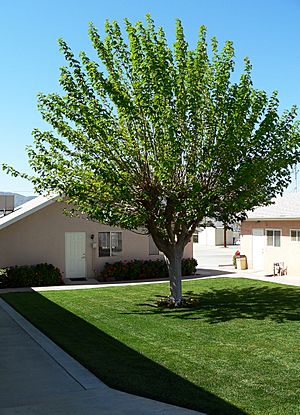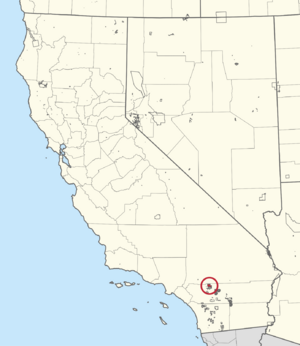Morongo Band of Mission Indians facts for kids

Moravian Church on the Morongo Reservation
|
|
| Total population | |
|---|---|
| 996 | |
| Regions with significant populations | |
| United States (California) | |
| Languages | |
| English, Pass Cahuilla, and Serrano. | |
| Religion | |
| traditional tribal religion, Christianity (Roman Catholicism) |
|
| Related ethnic groups | |
| other Cahuilla, Cupeño, and Serrano peoples |
The Morongo Band of Mission Indians is a Native American tribe in California, United States. A "federally recognized tribe" means the U.S. government officially recognizes them as a sovereign nation. The main groups within the Morongo Band are the Cahuilla and Serrano people. Other members include Cupeño, Luiseño, and Chemehuevi Indians.
Many tribes in California are called "Mission Indians" because they were connected to the old Spanish Missions in California. However, the Morongo people were never part of these missions.
The Morongo Reservation is their homeland. It is located in Riverside County, California, near the San Gorgonio Pass. This land was first set aside in 1876 by President Ulysses S. Grant. It was originally called the Potrero Reservation and known as Malki by the Native Americans. By 1908, the name "Morongo" was officially adopted. Today, the tribe has built a large casino and hotel resort in Cabazon, California. This helps create jobs and money for the tribe's well-being and growth.
Contents
The Morongo Reservation
The Morongo Reservation (33°57′10″N 116°48′28″W / 33.95278°N 116.80778°W) sits at the base of the San Gorgonio and San Jacinto Mountains. It covers more than 35,000 acres (14,000 ha) of land. On May 15, 1876, President Ulysses S. Grant created this reservation, along with eight others in the area. This was done through an "executive order," which is a rule made by the President. About 954 of the 996 tribal members live on the reservation.
The name Morongo comes from the Serrano clan called Maarrenga. The first official leader of the area, recognized by the Bureau of Indian Affairs, was John Morongo. He was the hereditary leader of the Maarrenga clan. Over time, the Bureau started calling the tribe the Morongo Band of Mission Indians.
Education for Tribal Members
Students living on the reservation attend schools in the Banning Unified School District.
Native Languages
The Cahuilla and Serrano languages are part of the Uto-Aztecan language family. The original people of the San Gorgonio Pass are the Pass Cahuilla, who call this area Maalki. The Serrano people, who have lived in the area for a long time and often married into Cahuilla families, call the area Maarrkinga.
Sadly, the Cahuilla and Serrano languages are not spoken at home anymore. Children are not learning them as their first languages. Joe Saubel, a Morongo tribal member and the last person who spoke pure Pass Cahuilla, passed away in 2008. The last person who spoke pure Serrano, Ms. Dorothy Ramon, also a Morongo member, died in 2002.
However, recent generations are showing new interest in their native languages. Many families are now working to teach their children Pass Cahuilla or Serrano. In 2012, a group called the Limu Project announced they had successfully rebuilt the Pass Cahuilla language. They now offer online courses. The project also has online courses for the Maarrenga' (Morongo Band "Serrano" dialect) and Yuhaviat (Santos Manuel Band "Serrano" dialect).
Tribal Programs and Development
Gaming and the Casino
In 1983, the tribe opened a small bingo hall. This was the start of what became one of California's oldest Native American gaming businesses. The government of Riverside County, California, tried to close the bingo hall. The tribe, along with the Cabazon Band of Mission Indians, sued the local government. This case eventually went all the way to the U.S. Supreme Court. On February 25, 1987, the court decided that Native American tribes have the right to run gaming businesses on their reservations.
The Morongo Casino, Resort & Spa opened in 2004 in Cabazon, California. It is open every day, all day long. The hotel has 310 rooms. There are several places to eat and drink, and a club called 360 that is open on weekends.
Water Resources
The tribe also helped develop a water bottling plant on the reservation. This plant is run by Nestle Waters North America Inc., which rents the land from the tribe. The plant bottles Arrowhead spring water and purified water under the brand Nestle Pure Life.
Cultural Preservation
The Malki Museum on the Morongo Reservation is open to everyone. It has a publishing house called Malki Museum Press. This press publishes the Journal of California and Great Basin Anthropology and academic books about Native American culture. The reservation is also home to the Limu Project. This is a non-profit group that helps families keep their native languages, history, and cultural traditions alive.
Churches on the Reservation
There are two churches on the Morongo Reservation. One is the Protestant Morongo Moravian Church. The other is the Catholic St. Mary's Mission, which is part of the Saint Kateri Tekakwitha Catholic Community.
Notable Tribal Members
- Marigold Linton (born 1936), a well-known psychologist, educator, and author.



